A backlink audit is essential if you are to looking to ensure your SEO campaign is both effective and safe. Gone are the days of comment linking, paying for links & hidden links, these tactics will most likely get your site penalised in the long run.
This is one of the main reasons I advise those who are looking to gain visibility not to invest in super cheap SEO services. This is the exact tactics they will use. I am going to take you through how to complete a backlink audit and what changes you can make to add value to your overall website health.
The majority of businesses might not even have a backlink strategy and a lot of companies I know don’t even know about the negative links pointing to their site and the potential damage it can do to their business. I would advise all business owners who rely on their website to generate revenue, make sure you do this or invest in an SEO who will review this for you.
What is a backlink audit?
Before jumping into what you need to do, we need to understand why a backlink audit is needed. A link audit is essentially looking at your current backlink profile and evaluating the following.
- How good are these links for your website?
- Is this link natural?
- Is the link relevant to your brand?
- Is the content relevant?
- Is the source an authoritative website?
Link audit can take a very long time as the best way to achieve the best results is manually looking at each link. If you have got a site with thousands of links, this would take several hours. So, I’ll take you through some of the tools I use to complete a backlink audit.
Step 1: Finding Your Backlinks
The first step is finding your backlinks. Google Search Console is a great tool for this, and it’s free. Every webmaster should have this set up.

On the left-hand side, you will see the links section.
In the link section you see information around both internal links & external links as well as an insight into the most common anchor text for your links.
Search console will also give you a view of what websites link to you the most.
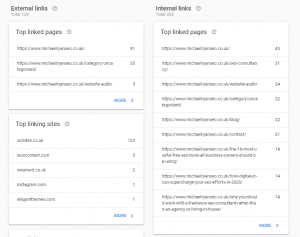
Step 2: Analyse your backlinks
Once you can visualise your backlink and where they are coming from, you can start to analyse them against the criteria I mentioned at the beginning of the article.
Again there are a few we can do this.
Check them manually
In most cases this is not going to be viable. The time it would take you to check all links manually would be far too long. However, if you have only had your site running a short amount of time with a limited amount of links. This might be ok for you. It is definitely the best way of checking a link as relevance can be hard for a tool to understand.
Use a backlink audit tool
There are a few different tools you can use for this, they vary in the language they use but essentially you want a view of the following
- Amount of backlinks
- Number of referring domains
- Quality of site (Domain authority/citation flow)
3.Best tools for backlink audits
There are 2 tools that I think give the best overview in your backlink profile, both also have great features for those looking for opportunities to build links.
Majestic
Majestic is a tool that specliases in backlinks rather than being an all-in-one SEO tool. You’re not going to find any info or tools on keyword research or search volume ext. It’s essentially a huge link index. You crawl a site using the search bar, and you see specifics on the domains backlink profile.

Once you enter your domain, this instance you’re going to want to view links across your domain like below.

You could crawl a specific URL in which you want to view backlinks for but we’re focusing on the whole site’s backlink profile here.
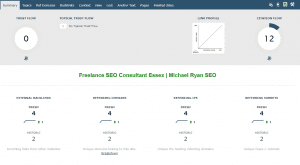
The crawl will initially provide you with the following information.
- Number of external backlinks
This is the total number of backlinks you have coming for all domains.
- Referring domains
This looks at the exact number of domains that link to you, rather than the total number of links. For example, you could have 50 referring domain but those 50 domain links to you 2000 times, so the number of external backlinks would be 2000. I would advise keeping this as close to a 1:1 ratio as you can as in most cases it is natural to only links once rather than constantly getting links from the same source.
- Referring IP
Amount of referring IP addresses are linking to you – again you want these to mostly be unique, rather than from the same IP address.
- Referring Subnet
This is short for referring C-subnet – basically are the websites you are getting links from in the same network? Again, we don’t want this to be the case.
My site is new so the amount of data is quite low.
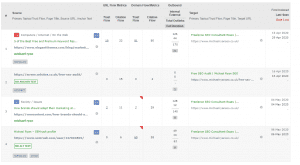
The next step is to utilise the backlinks tab. This will help you drill down the links that don’t look as natural. Here you should be looking at:
- The source of the link – is it a website that is relevant to what you do as a business.
- The content on the page linking to you – again, is it relevant to you as a business?
- Trust flow & citation flow – the higher the better, however, newer sites may have a lower score here but still be super relevant.
- Anchor text & target link – is the page linking the most relevant page on your website with natural anchor text?
SEM Rush Backlink Audit
SEM Rush does the manual checking for you by giving a toxic score against links you have pointing to your domain. This is extremely handy if you have a large backlink profile as it can essentially act as a filter enabling you to review the links that come up as toxic.
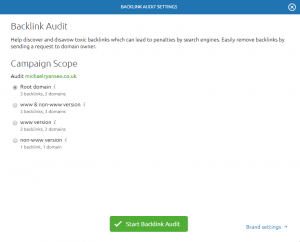
Some after manually checking might be ok to keep but it definitely speeds up the process.
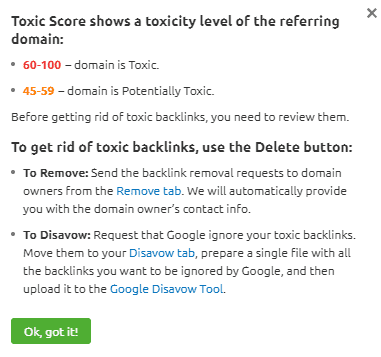
Another great feature that SEM Rush has is the fact you can link it with your Google search console account as per below. It’s relatively easy to sync and you just need to give them permission by adding their email as a user. This will help them generate further data needed for SEM rush to effectively audit your site.
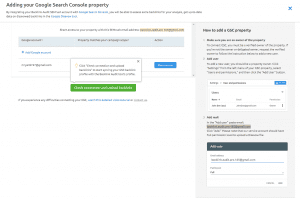
4.Fix & Plan Ahead
The last step is to fix any issues you see & plan ahead by creating a plan of how you’re going to add value to your back-link profile.
You should be looking at fixing dead links or links that do not go to the correct URL. Don’t be scared to email the webmaster and ask them to change the anchor or the URL the links pointing to.
Disavow links that are not natural and could be causing harm to your site.
In terms of planning ahead, look at your competitor’s backlink profile for inspiration on where there are getting their links and how.
Conclusion
I hope this was an easy enough guide to follow. Completing a backlink audit can be a daunting task and might be at the bottom of your list, however, it’s vital to ensure your backlink profile is natural as it can undo good work you’ve already done.
Author: Michael Ryan SEO limited is an SEO agency in Essex that role focus is to boost ROI for his clients.



